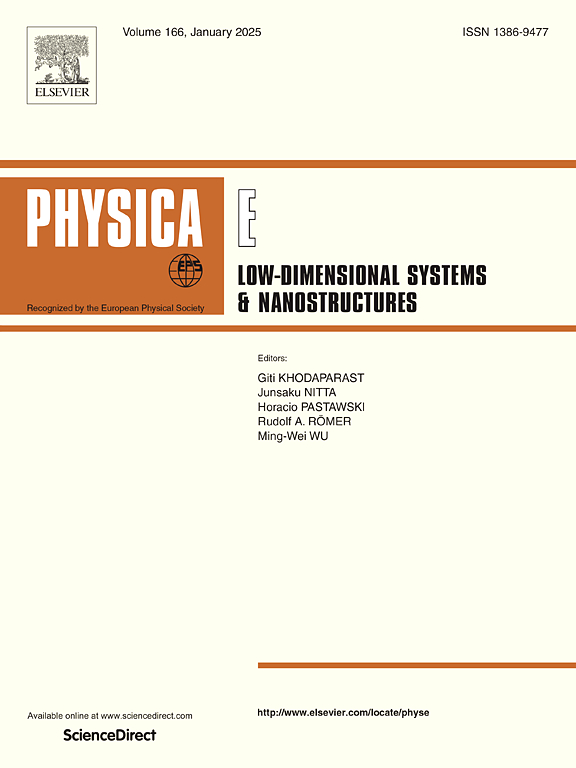用于生物分子检测的基于vo2的短段和矩形腔的等离子体折射率传感器
IF 2.9
3区 物理与天体物理
Q3 NANOSCIENCE & NANOTECHNOLOGY
Physica E-low-dimensional Systems & Nanostructures
Pub Date : 2025-05-29
DOI:10.1016/j.physe.2025.116307
引用次数: 0
摘要
本文介绍了一种基于长条结构矩形谐振腔的等离子体金属绝缘体金属传感器的理论研究。在MIM波导配置的短管中集成了VO2,为生物分子和折射率传感应用的可调谐传感引入了一种新的方法。分析了该器件在绝缘体态和金属态下的传感特性,结果表明该器件的折射传感共振峰增强。该装置对水、丙酮和二甲亚砜的两种共振模式的灵敏度为666nm/RIU,质量因子(Q)为47.56,品质因数(FOM)为18。此外,该装置通过检测大量脑癌细胞成分和区分DNA样本,显示出强大的生物传感潜力。对于脑癌的检测,对金属态和绝缘体态VO2的最大灵敏度分别达到950.11 nm/RIU和826.11nm/RIU。在绝缘体状态下,成神经管细胞瘤的Q因子为91,FOM为33.2,而在VO2的金属状态下,FOM为47.5,Q因子为57。此外,该设备还可以区分不同的DNA样本,可以实现Q为62,FOM为22。设备优化是通过改变设备参数来实现的,并且已经观察到它们对设备性能的显著影响。通过改变矩形腔体的内部尺寸,可以计算出最高的质量因子86。由于能够检测1.33至1.56范围内的多种折射率,所提出的设备为生物传感和折射率应用提供了重要的应用。本文章由计算机程序翻译,如有差异,请以英文原文为准。
VO2-operated stub and rectangular cavity-based plasmonic refractive index sensor for biomolecules detection
This paper introduces a theoretical study of plasmonic metal insulator metal (MIM) sensor based on a rectangular resonator with a stub structure. The integration of VO2 in the stub in a MIM waveguide configuration introduces a novel approach for tunable sensing for biomolecules and refractive index sensing applications. The sensing property of the device is analyzed for both the insulator and metallic states of the VO2 showing enhanced resonance peaks for refractive index sensing. The device achieves a sensitivity of 666nm/RIU for its two resonance modes with quality factor (Q) of 47.56 and figure of merit (FOM) of 18 for water, acetone and dimethyl sulfoxide. Further, the device shows its strong biosensing potential by detecting numerous brain cancer cell components and differentiating between DNA samples. For brain cancer detection, maximum sensitivity of 950.11 nm/RIU and 826.11nm/RIU is achieved for the metallic and insulator state of VO2 respectively. In the insulator state, a Q factor of 91 and FOM of 33.2 is achieved for Medulloblastoma, whereas for the metallic state of VO2, an FOM of 47.5 and a Q factor of 57 is obtained. Additionally, the device can also differentiate between different DNA samples and can achieve Q of 62 and FOM of 22. Device optimizations are performed by changing device parameters and their significant effect on device's performance has been observed. The highest quality factor of 86 is calculated by changing the internal dimensions of the rectangular cavity. With the ability to detect numerous refractive indexes in the range from 1.33 to 1.56, the proposed device offers significant applications for biosensing and refractive index based applications.
求助全文
通过发布文献求助,成功后即可免费获取论文全文。
去求助
来源期刊
CiteScore
7.30
自引率
6.10%
发文量
356
审稿时长
65 days
期刊介绍:
Physica E: Low-dimensional systems and nanostructures contains papers and invited review articles on the fundamental and applied aspects of physics in low-dimensional electron systems, in semiconductor heterostructures, oxide interfaces, quantum wells and superlattices, quantum wires and dots, novel quantum states of matter such as topological insulators, and Weyl semimetals.
Both theoretical and experimental contributions are invited. Topics suitable for publication in this journal include spin related phenomena, optical and transport properties, many-body effects, integer and fractional quantum Hall effects, quantum spin Hall effect, single electron effects and devices, Majorana fermions, and other novel phenomena.
Keywords:
• topological insulators/superconductors, majorana fermions, Wyel semimetals;
• quantum and neuromorphic computing/quantum information physics and devices based on low dimensional systems;
• layered superconductivity, low dimensional systems with superconducting proximity effect;
• 2D materials such as transition metal dichalcogenides;
• oxide heterostructures including ZnO, SrTiO3 etc;
• carbon nanostructures (graphene, carbon nanotubes, diamond NV center, etc.)
• quantum wells and superlattices;
• quantum Hall effect, quantum spin Hall effect, quantum anomalous Hall effect;
• optical- and phonons-related phenomena;
• magnetic-semiconductor structures;
• charge/spin-, magnon-, skyrmion-, Cooper pair- and majorana fermion- transport and tunneling;
• ultra-fast nonlinear optical phenomena;
• novel devices and applications (such as high performance sensor, solar cell, etc);
• novel growth and fabrication techniques for nanostructures

 求助内容:
求助内容: 应助结果提醒方式:
应助结果提醒方式:


